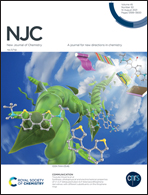Zn-Promoted gene transfection efficiency for non-viral vectors: a mechanism study†
Abstract
The development of cationic non-viral gene vectors that may overcome obstacles in gene delivery is of great significance to the gene therapy. Metallic complexes with high affinity to nucleic acids are ideal new options for delivery systems. In this report, a 1,4,7,10-tetraazacyclododecane (cyclen)-based polymer and its Zn(II) complex were prepared as a non-viral gene delivery vector. It was found that a Zn-coordination improved the gene transfection efficiency while slightly reducing the cytotoxicity of the polymer. This study focused on the mechanism of such improvement. Acid–base titration results revealed that Zn-coordination significantly increased the pH buffering capacity of the cationic material and the enhanced “proton sponge effect” might facilitate the endosomal escape, which was confirmed by confocal laser scanning microscopy. Flow cytometry showed that Zn-coordination improved the cellular uptake, which might be attributed to the higher zeta-potential of the Zn-complex and the resulting stronger interaction between the Zn ion and cell membrane. Moreover, chloroquine/nigericin experiments further demonstrated that the higher transfection efficiency of the zinc complex was due to its better endosomal escape ability. These results may provide clues for the development of novel non-viral gene vectors with high endosomal escape ability and biocompatibility.



 Please wait while we load your content...
Please wait while we load your content...